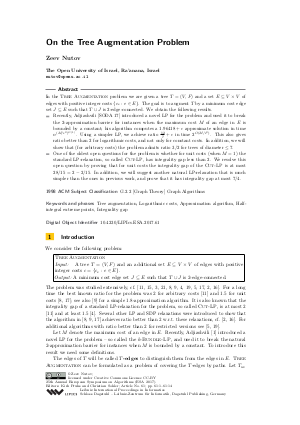On the Tree Augmentation Problem
Author Zeev Nutov
-
Part of:
Volume:
25th Annual European Symposium on Algorithms (ESA 2017)
Part of: Series: Leibniz International Proceedings in Informatics (LIPIcs)
Part of: Conference: European Symposium on Algorithms (ESA) - License:
 Creative Commons Attribution 3.0 Unported license
Creative Commons Attribution 3.0 Unported license
- Publication Date: 2017-09-01
File

PDF
LIPIcs.ESA.2017.61.pdf
- Filesize: 0.53 MB
- 14 pages
Document Identifiers
Subject Classification
Keywords
- Tree augmentation
- Logarithmic costs
- Approximation algorithm
- Half-integral extreme points
- Integrality gap
Metrics
- Access Statistics
-
Total Accesses (updated on a weekly basis)
0PDF Downloads0Metadata Views
Abstract
In the Tree Augmentation problem we are given a tree T=(V,F) and a set E of edges with positive integer costs {c_e:e in E}. The goal is to augment T by a minimum cost edge set J subseteq E such that T cup J is 2-edge-connected. We obtain the following results.
Recently, Adjiashvili [SODA 17] introduced a novel LP for the problem and used it to break the 2-approximation barrier for instances when the maximum cost M of an edge in E is bounded by a constant; his algorithm computes a 1.96418+epsilon approximate solution in time n^{{(M/epsilon^2)}^{O(1)}}. Using a simpler LP, we achieve ratio 12/7+epsilon in time ^{O(M/epsilon^2)}. This also gives ratio better than 2 for logarithmic costs, and not only for constant costs. In addition, we will show that (for arbitrary costs) the problem admits ratio 3/2 for trees of diameter <= 7.
One of the oldest open questions for the problem is whether for unit costs (when M=1) the standard LP-relaxation, so called Cut-LP, has integrality gap less than 2. We resolve this open question by proving that for unit costs the integrality gap of the Cut-LP is at most 28/15=2-2/15. In addition, we will suggest another natural LP-relaxation that is much simpler than the ones in previous work, and prove that it has integrality gap at most 7/4.
Cite As Get BibTex
Zeev Nutov. On the Tree Augmentation Problem. In 25th Annual European Symposium on Algorithms (ESA 2017). Leibniz International Proceedings in Informatics (LIPIcs), Volume 87, pp. 61:1-61:14, Schloss Dagstuhl – Leibniz-Zentrum für Informatik (2017)
https://doi.org/10.4230/LIPIcs.ESA.2017.61
BibTex
@InProceedings{nutov:LIPIcs.ESA.2017.61,
author = {Nutov, Zeev},
title = {{On the Tree Augmentation Problem}},
booktitle = {25th Annual European Symposium on Algorithms (ESA 2017)},
pages = {61:1--61:14},
series = {Leibniz International Proceedings in Informatics (LIPIcs)},
ISBN = {978-3-95977-049-1},
ISSN = {1868-8969},
year = {2017},
volume = {87},
editor = {Pruhs, Kirk and Sohler, Christian},
publisher = {Schloss Dagstuhl -- Leibniz-Zentrum f{\"u}r Informatik},
address = {Dagstuhl, Germany},
URL = {https://drops.dagstuhl.de/entities/document/10.4230/LIPIcs.ESA.2017.61},
URN = {urn:nbn:de:0030-drops-78345},
doi = {10.4230/LIPIcs.ESA.2017.61},
annote = {Keywords: Tree augmentation, Logarithmic costs, Approximation algorithm, Half-integral extreme points, Integrality gap}
}
Author Details
References
-
D. Adjiashvili. Beating approximation factor two for weighted tree augmentation with bounded costs. In SODA, pages 2384-2399, 2017.

-
J. Cheriyan and Z. Gao. Approximating (unweighted) tree augmentation via lift-and-project, part II. Manuscript, 2015.

-
J. Cheriyan, T. Jordán, and R. Ravi. On 2-coverings and 2-packing of laminar families. In ESA, pages 510-520, 1999.

-
J. Cheriyan, H. Karloff, R. Khandekar, and J. Koenemann. On the integrality ratio for tree augmentation. Operation Research Letters, 36(4):399-401, 2008.

-
N. Cohen and Z. Nutov. A (1+ln2)-approximation algorithm for minimum-cost 2-edge-connectivity augmentation of trees with constant radius. Theoretical Computer Science, 489-490:67-74, 2013.

-
M. Cygan. Private communication, 2016.

-
M. Cygan, F. Fomin, F. Kowalik, D. Lokshtanov, D. Marx, M. Pilipczuk, M. Pilipczuk, and S. Saurabh. Parameterized Algorithms. Springer, 2016.

-
G. Even, J. Feldman, G. Kortsarz, and Z. Nutov. A 3/2-approximation for augmenting a connected graph into a two-connected graph. In APPROX, pages 90-101, 2001.

-
G. Even, J. Feldman, G. Kortsarz, and Z. Nutov. A 1.8-approximation algorithm for augmenting edge-connectivity of a graph from 1 to 2. ACM Transactions on Algorithms, 5(2), 2009.

- S. Fiorini, M. Groß, J.Könemann, and L. Sanitá. A 3/2-approximation algorithm for tree augmentation via chvátal-gomory cuts. https://arxiv.org/abs/1702.05567, Feb 27, 2017.
-
G. Frederickson and J. Jájá. Approximation algorithms for several graph augmentation problems. SIAM J. Computing, 10:270-283, 1981.

-
M. Goemans, A. Goldberg, S. Plotkin, E. Tardos D. Shmoys, and D. Williamson. Improved approximation algorithms for network design problems. In SODA, pages 223-232, 1994.

-
D. Hochbaum, N. Megiddo, J. Naor, and A. Tamir. Tight bounds and 2-approximation algorithms for integer programs with two variables per inequality. Math. Programming, 62:69–83, 1993.

-
K. Jain. A factor 2 approximation algorithm for the generalized steiner network problem. Combinatorica, 21(1):39-60, 2001.

-
S. Khuller and R. Thurimella. Approximation algorithms for graph augmentation. J. of Algorithms, 14:214-225, 1993.

-
G. Kortsarz and Z. Nutov. LP-relaxations for tree augmentation. In APPROX-RANDOM, pages 13:1-13:16, 2016.

-
G. Kortsarz and Z. Nutov. A simplified 1.5-approximation algorithm for augmenting edge-connectivity of a graph from 1 to 2. ACM Transactions on Algorithms, 12(2):23, 2016.

-
L. C. Lau, R. Ravi, and M. Singh. Iterative Methods in Combinatorial Optimization. Cambridge University Press, 2011.

-
Y. Maduel and Z. Nutov. Covering a laminar family by leaf to leaf links. Discrete Applied Mathematics, 158(13):1424-1432, 2010.

-
D. Marx and L. Végh. Fixed-parameter algorithms for minimum-cost edge-connectivity augmentation. ACM Transactions on Algorithms, 11(4):27, 2015.

-
H. Nagamochi. An approximation for finding a smallest 2-edge connected subgraph containing a specified spanning tree. Discrete Applied Mathematics, 126:83-113, 2003.

